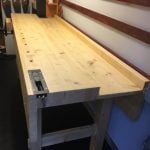Formaldehyde in plywood and osb harmful— allergies & potentially cancerogenic.
Welcome! / Forums / General Woodworking Discussions / Wood and Wood Preparation / Formaldehyde in plywood and osb harmful— allergies & potentially cancerogenic.
- This topic has 3 replies, 4 voices, and was last updated 4 years, 6 months ago by
 Sven-Olof Jansson.
Sven-Olof Jansson.
-
AuthorPosts
-

I am buliding a new small woodworking workshop, and thought about using OSB to cover the walls. At about the same time I underwent some allergy tests as I have a lot of skin problems, and found out I was allergic to formaldehyde. So did a bit of research, and found out that formaldehyde gas is released from plywood and OSB overtim. (As it ages the release of formaldehyde is reduced).
However, I also found out it does not only cause allergies for me, BUT some studies of humans have suggested that formaldehyde exposure is associated with certain types of cancer.
See article: https://www.cancer.gov/about-cancer/causes-prevention/risk/substances/formaldehyde/formaldehyde-fact-sheet
So, plywood and OSB is for me a “no” going forward. There’s now also formaldehyde free plywood available but haven’t come acros it yet here in Sweden.
Just wanted to share.
29 July 2019 at 5:49 am #594277I’m sure your allergy is real. I’m also afraid it’s a bit more complicated than “plywood bad, wood good”.
First, formaldehyde free and phenol glues in wood products are probably more prevalent than you think. it turns out that HPVA and soy based glues are often cheaper than formaldehyde based glues. Purebond ™ ply is formaldehyde free. You should ask your supplier for an SDA datasheet, which they must by law provide for all products sold. I know there are formaldehyde free birch ply panels made in Sweden. I think you have to find actual lumber suppliers who know their products. A clerk in a box store won’t be much help.
Although phenol glues are made with formaldehyde, it’s bound in the glue and they don’t outgas it unless you burn it. https://www.kemi.se/en/rules-and-regulations/rules-applicable-in-sweden-only/swedish-restrictions-and-bans/swedish-rules-on-formaldehyde-in-wood-based-boards
But it also contains Polymeric Diphenylmethane Diisochyanate, which is itself toxic. So the high resin content in OSB probably precludes it’s use. I never used it anyway as we considered it a substandard product strngthwise.
Plywood uses less of it, the free formaldehyde goes away quickly, and here in lumber country ply isn’t much more money.Second. EU and Swedish law require that all wood based products must pass the E1 emissions standard and must be tested to emit less than .01 parts per million immediately after manufacture. That’s three times lower than the .03 ppm the US consumer product safety commission link you posted says is safe and ten times lower than the .1 ppm the link says is of concern and noticeable. It may well be that the way plywood makers there comply with the law is by not using formaldehyde glues. And as you state, most outgassing is right after manufacture.
With recommended air changes I doubt any health risk have been established at the low .01 PPM level. Fruits like apples, bananas, grapes, and plums; vegetables like onions, carrots, and spinach; and even meats like seafood, beef, and poultry contain and outgas formaldehyde. Even humans “outgas” formaldehyde. It’s a natural part of digesting certain amino acids. If your allergy is acute, don’t eat or have those foods in your house.
Third, natural “ untreated “ wood products on the retail market are often treated with substances as toxic and volatile, or more so, than formaldehyde, including saw lubricants, pesticides, benzine based fungicides, and glycol dessicants and water replacers to lessen shrinkage. These are usually applied as a spray or by dunking when the wood is cut.
The fungicides include didecyldimethyl ammonium chloride, 3-iodo-2-propynyl butyl carbamate, azaconazole, borax and 2-(thiocyanomethylthio) benzthiazole. have fun looking those up. Borax is a common bug poison.I suppose you could forego the treatmemt by buying at a small sawmill but some fungi in wood can be quite harmful and is the reason they treat.
Fourth, natural woods outgas all sorts of toxic substances as a product of processing and decay. Certain woods outgas formaldehyde and harmful resins, benzines, and even cyanide. I didn’t know until I moved to the pacific NW that I am allergic to the outgas products of Western red Cedar ( resins, formaldehyde and cyanide) and Hemlock ( fungi from the tree, not the toxic parsnip-like plant.) Both are quite common woods out here. Check a wood databases or google for the wood you contemplate using. Some woods also contain high silica content so breathing in dust from them is quite harmful.
The hazards for harm from the product worked with power tools, for example, are more recognized than they were.
Of particular concern for toxicity are most cedars, maples, acacia, and walnut. Of course pines affect some people. Laurel and Black Cherry can emit cyanide and cherry is my favorite wood. I use them all anyway. Ventilate and wear a mask if you make dust.I’m not saying your concern is groundless and that you don’t have a sensitivity above normal, everybody is affected by formaldehyde at some level. But all wood processing and use has its risks. It is more complicated than you stated.
4 October 2019 at 5:26 pm #614877I am sorry to hear that you have allergies. I’m a Ph.D. chemist (not a medical doctor). In graduate school in the early 1990s, the common practice where I was (California, USA) was to be careful with formaldehyde. We were told it was carcinogenic. Better safe than sorry was my approach.
For my personal homes, I haven’t worried too much about what is in it as they were for the most part a decade old so I assumed whatever initial outgassing had occurred and whatever was still occurring would be at a reduced level. If I were building new, I would probably look for things that were formaldehyde free.
I try and be pragmatic to solve problems such as you mentioned. If you are comfortable inside your home without allergies, I might look into using materials that match your home. If you are having allergies/issues with what is inside your home, I would look at brick/concrete blocks, or maybe some of that thin steel material they use to build interior walls of high rise buildings. I think there also products called Hardiboard in the USA that is some sort of fiberboard cement. Just options to explore. Good luck.
 5 October 2019 at 11:28 pm #615308
5 October 2019 at 11:28 pm #615308@Zeppos kindly provided a link to the evidence behind his concerns, and as US federal authorities and agencies often are quite transparent on the backgrounds to their conclusions (FDA being positively outstanding when compared to its European counterpart), one can evaluate the robustness of the data behind the conclusions drawn by the National Cancer Institute on the carcinogenic potential of formaldehyde: and conclude that it is weak.
-
AuthorPosts
- You must be logged in to reply to this topic.
